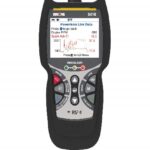The error code P0420 is a common issue that many car owners face, and it signals a problem with your vehicle’s catalytic converter efficiency. Specifically, it means your car’s computer, the Engine Control Unit (ECU), has detected that the catalytic converter is not cleaning exhaust gases as effectively as it should be. While often pointing towards catalytic converter problems, diagnosing and fixing code P0420 requires a systematic approach to pinpoint the exact cause and ensure a lasting repair.
Several factors can trigger the P0420 code. While a failing catalytic converter is a primary suspect, it’s crucial to understand that other components in your vehicle’s emission control system can also contribute to this code. Incorrect readings from oxygen sensors, exhaust leaks, and even engine performance issues can all lead to a P0420 error.
One potential cause, as mentioned in online forums, is an exhaust leak. Any leak in the exhaust system before or around the catalytic converter can disrupt the proper functioning of the emissions system and trigger a P0420 code. This is because unmetered air entering the exhaust stream can affect the readings of the oxygen sensors, making it seem like the catalytic converter is not working efficiently. Therefore, a thorough visual inspection of the exhaust system for any signs of leaks – such as unusual noises, rust, or cracks – is a crucial first step in diagnosing P0420.
Another point to consider is the role of the oxygen sensors. Modern vehicles use oxygen sensors (O2 sensors) both before (upstream or front sensor) and after (downstream or rear sensor) the catalytic converter. The front sensor monitors the oxygen levels in the exhaust gas before it enters the converter, helping the ECU adjust the air-fuel mixture for optimal combustion. The rear sensor, crucially, monitors the oxygen levels after the converter. It’s designed to see a reduced level of oxygen fluctuation compared to the front sensor if the catalytic converter is working correctly.
If the rear sensor output varies significantly, this is often what sets the P0420 code. The ECU interprets a fluctuating signal from the rear sensor as an indication that the catalytic converter is not efficiently reducing pollutants. However, it’s important to note that while measuring the rear sensor’s voltage can confirm the ECU’s reading, it doesn’t definitively confirm the catalytic converter is faulty.
It’s also worth noting that problems with the front oxygen sensor can indirectly cause a P0420 code. If the front sensor becomes “slow” or inaccurate, as some experienced mechanics have observed, it can lead to larger swings in the air-fuel mixture. These wider mixture fluctuations can overwhelm the catalytic converter’s capacity to clean up the exhaust, resulting in increased emissions downstream and triggering the P0420 code due to the rear sensor detecting these variations.
To properly diagnose a P0420 code, testing the oxygen sensors is a logical step. One suggested method involves measuring the voltage at the rear oxygen sensor. A healthy rear sensor after a functioning catalytic converter should show a relatively steady, low voltage (around 200mV, though this can vary by vehicle). If the voltage on the rear sensor is fluctuating significantly (for example, between 100mV and 600mV), it could indicate that the catalytic converter is indeed not working effectively. However, as highlighted, this test alone isn’t conclusive proof of catalytic converter failure.
For a more comprehensive assessment of oxygen sensor function, especially the front sensor, using an oscilloscope or scopemeter is recommended. A standard voltmeter may not be sufficient to capture the rapid switching of a properly functioning front oxygen sensor, which cycles its output voltage approximately twice per second. An oscilloscope can visualize these rapid voltage changes, allowing for a more accurate assessment of the sensor’s response time and overall health.
If you have the necessary diagnostic tools and technical expertise, further troubleshooting steps like oxygen sensor testing are valuable. However, if you need to pay for professional testing, you should consider the cost-effectiveness of sensor replacement. In some cases, replacing the oxygen sensors, particularly the rear sensor, might be a prudent first step, especially given that sensor malfunctions are a known cause of P0420 and sensors have a limited lifespan. Furthermore, it is often recommended to replace the oxygen sensors when replacing the catalytic converter itself to ensure optimal performance of the emissions system and prevent future issues.
In conclusion, the P0420 code indicates a catalytic converter efficiency problem, but the root cause can be varied. A methodical diagnostic approach, starting with visual inspections for exhaust leaks, considering oxygen sensor health, and potentially utilizing tools like oscilloscopes for sensor testing, is crucial. While DIY troubleshooting is possible, seeking professional diagnosis and repair is advisable if you lack the tools or expertise, ensuring the issue is correctly identified and resolved for long-term vehicle health and emissions compliance.
